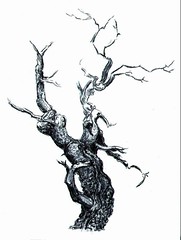In an essay in his book (which I have been reading), To The Rescue of Art, Rudolf Arnheim (1904-2007) explains how the composition of a double portrait by Edgar Degas affects how we think about the relationship between the couple portrayed. Here is the portrait:
Edmondo and Thérèse Morbilli, 1867
Edgar Degas (1834-1917)
Source: The Athenaeum
Degas painted this picture of his sister and her husband in 1867. Arnheim points out Thérèse's fearful expression, her hand on her face and the other hand barely touching her husband's back as if she's afraid of him, the shadow of her husband on her face, the fact that she is behind him and taking much less space than he does in the picture, the "reserved and suspicious" look on his face, his knee thrust "forward against the viewer," the spreading out of his elbows to take over as much room as possible (as she, in contrast, shrinks away), and "the almost brutal insensitivity of the husband's domineering right hand." As Arnheim says, "The message could not be clearer." I think we can all agree with that; this is not the kind of marriage that a woman hopes for.
Arnheim goes on to say that this type of pose was new to art, and the reason behind it was photography.
Degas did not begin taking photographs himself until he was sixty-one years old, in the mid-1890s (at which time he became a very enthusiastic photographer); however, he had been interested in photography for three decades by that time. See my earlier post on Degas and Photography.
Arnheim explained that in earlier times painters (and sculptors) portrayed their subjects in conventional ways utilizing conventional gestures; but when people who were not aware of or didn't see the need for or didn't have the patience -- or their subjects didn't have the patience -- to follow those conventions started taking pictures with cameras, there were endless examples of "unposed" or "accidental" poses. "What is new here," writes Arnheim about this painting, "is that the telling constellation is caught in the kind of accidental pose that may come about when the visiting brother asks the family to let him take a snapshot."
In other words, as I understand it, he meant not that Degas caught them in such a pose and got it down fast; rather, Degas was aware of what an accidental pose could reveal and so he invented a very un-accidental "accidental-looking" composition in order to say what he wanted to say about the couple. The result is that it looks very real to us and we feel a great deal of uneasiness when looking at the picture.
I don't mean to imply that what we "know" about this couple as a result of seeing this painting is the complete truth about them, or even that it our interpretation (or Arnheim's) of their relationship is necessarily completely accurate. The point is that how we feel about them is a result of how Degas painted them, and he was quite aware of what he was doing.
As an interesting aside, I want to add another painting, of the same couple, that Degas painted a year or two earlier. It is nothing like the painting discussed above.
Edmondo and Thérèse Morbilli, 1865-66
Edgar Degas
Source: Source: The Athenaeum
In this painting of the same couple, Degas' sister and her husband, it is his sister who is dominant and the feeling is extremely different. Between the time Degas painted this portrait and the one in 1867 the couple lost a child, and this might help explain the change in the way they felt about themselves and each other and the way they were seen by Degas, and it also might help us interpret the "signs" a little differently.
_____



3 comments:
Dear Jean,
I enjoyed reading the interpretation of the first painting. It's amazing how much emotion and information can be coded in a single painting. We may be aware of it subconsciously, but it becomes all the more clear to us when described so well with words.
Petya, I agree. Before I read the essay I would hardly have given this picture a second glance, thinking of it as - although very well done - unpleasant to look at. Now I find it interesting and will be looking more for these kinds of things.
This was very interesting, Jean, and I really enjoyed seeing the earlier painting beside the first you discuss (the one painted later). Understanding what this couple has been through lends enormous insight to what would otherwise be a somewhat uncomfortable, troubled-looking double portrait. Strangely, though, I read the expressions and body language in this painting somewhat differently on first looking. The husband seems weary and guarded to me but protective, sheilding his wife from the world. She is anxious but her hand on his shoulder seems spontaneous and gentle to me. I see troubled people but not a troubled marriage, but can certainly appreciate the interpretation you've offered as well. A very interesting and thought-provoking article...
Post a Comment